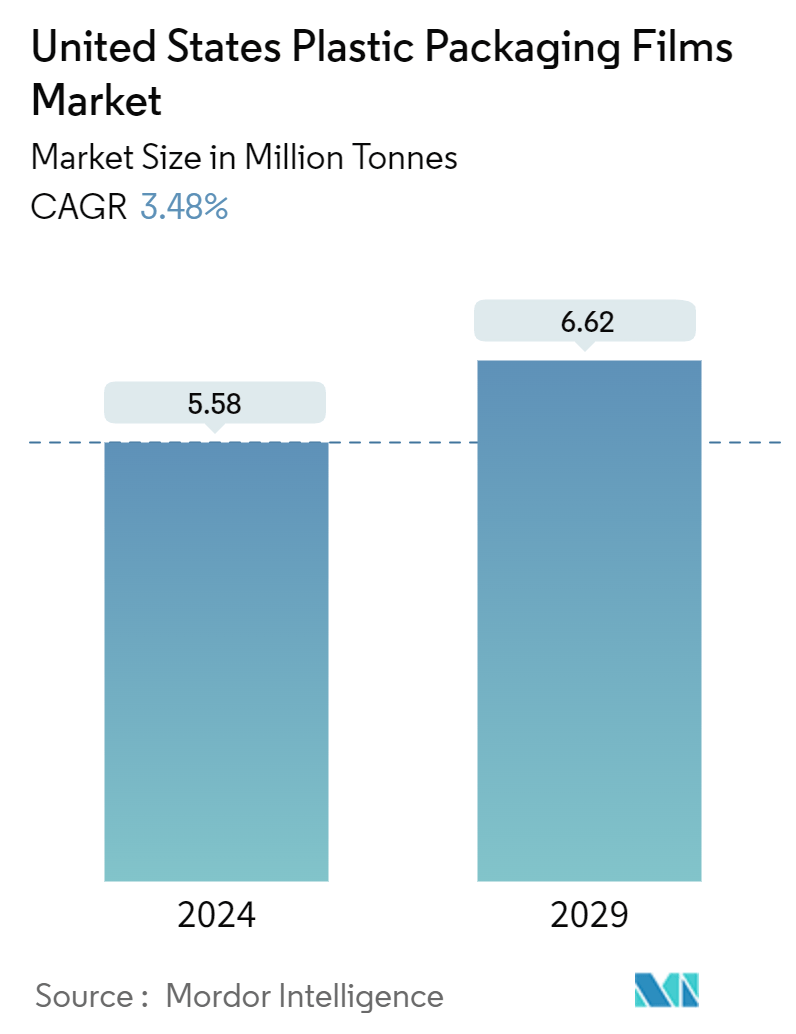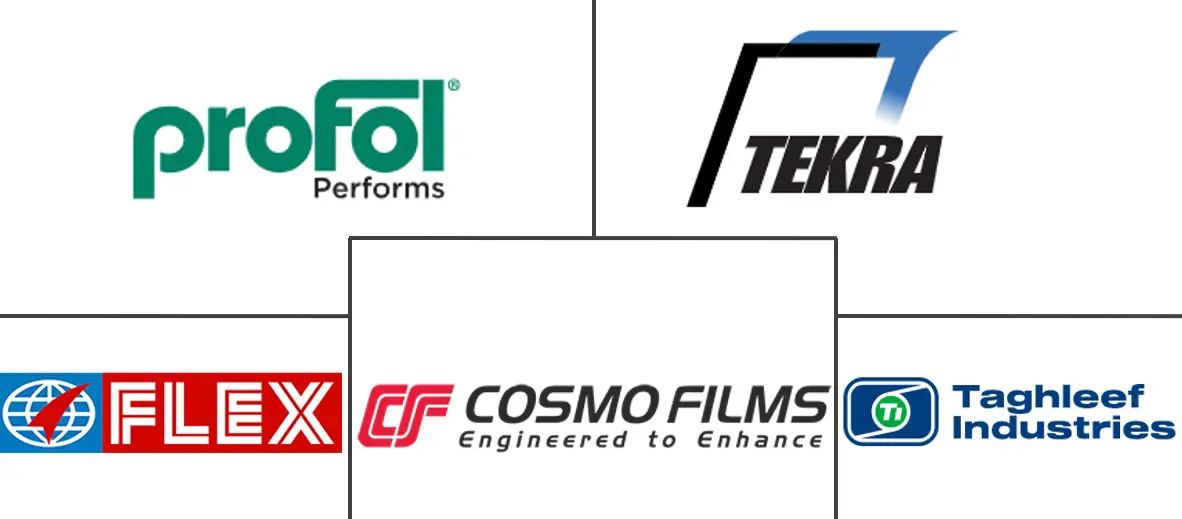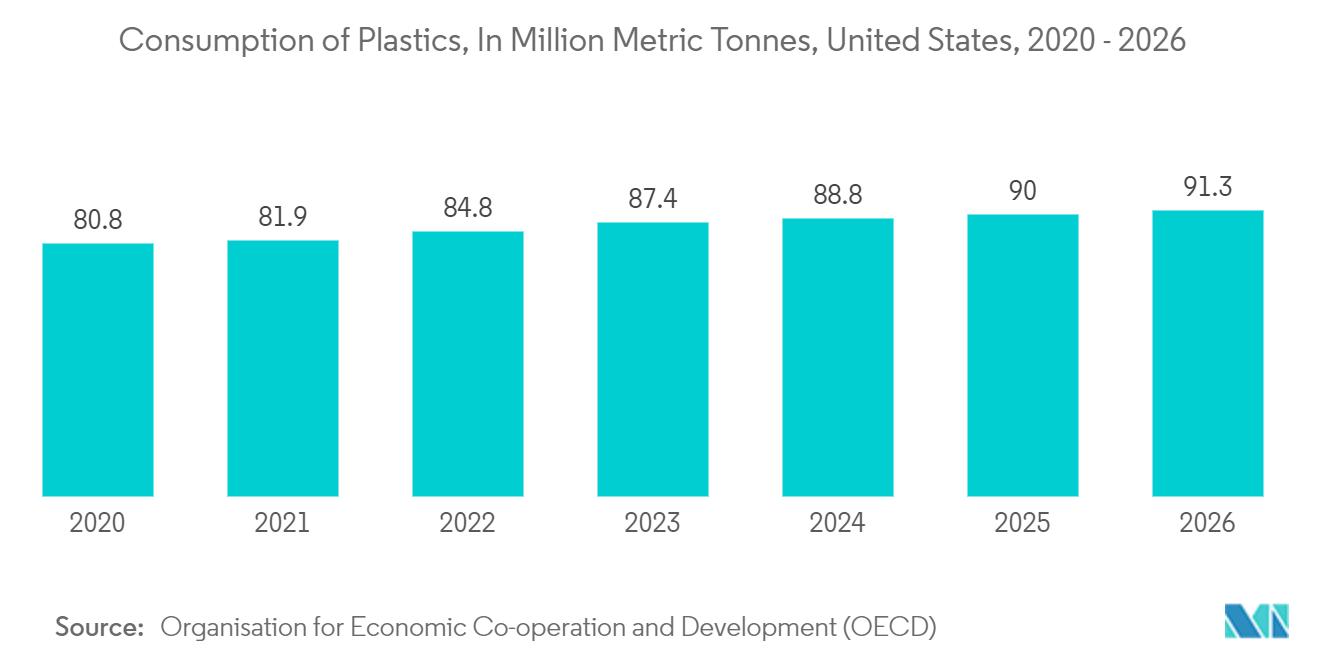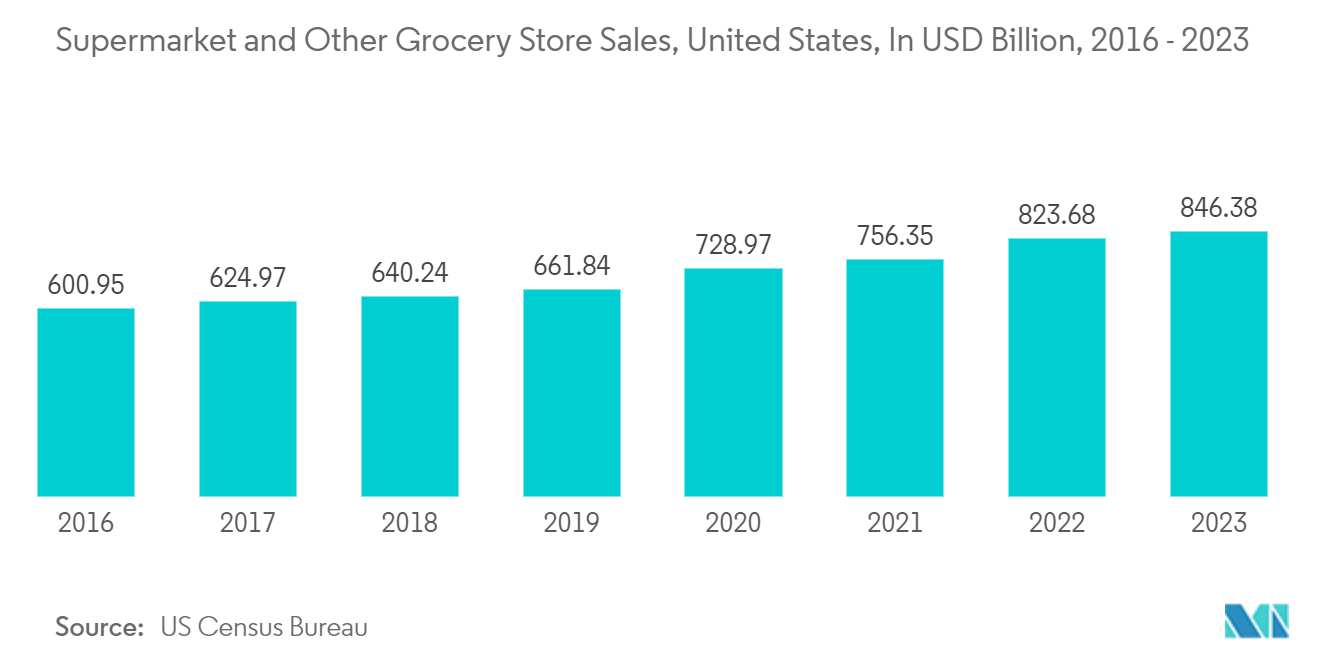United States Plastic Packaging Films Market Size

| Study Period | 2019 - 2029 |
| Base Year For Estimation | 2023 |
| Market Volume (2024) | 5.58 Million tonnes |
| Market Volume (2029) | 6.62 Million tonnes |
| CAGR (2024 - 2029) | 3.48 % |
| Market Concentration | Low |
Major Players
*Disclaimer: Major Players sorted in no particular order |
United States Plastic Packaging Films Market Analysis
The United States Plastic Packaging Films Market size is estimated at 5.58 Million tonnes in 2024, and is expected to reach 6.62 Million tonnes by 2029, growing at a CAGR of 3.48% during the forecast period (2024-2029).
- The US plastic packaging film market is growing vibrantly, creating unique solutions for multiple packaging challenges. In recent years, various end-user industries, such as food, healthcare, cosmetics and toiletries, and others (consumer products, pharma, industrial applications, pet food), have increased demand for plastic films.
- In the United States, the flexible packaging industry employs over 85,000 individuals. This large workforce supports the entire packaging ecosystem, including suppliers of raw materials, machinery, and technology. This can lead to better supply chain integration and support the growth of the plastic packaging film market.
- The country’s population gravitates towards highly effective and convenient packaging. Urbanization, busy work schedules, and time pressure drive people toward ready-to-eat meals that come in flexible films. In addition, the rise in the demand for on-the-go snacks has led to the need for plastic packaging films, which offer convenience to consumers. In addition, changing consumer lifestyles, food preferences, and food technology further boost the market's demand.
- According to the US Census Bureau, from April to June 2023, US retail e-commerce sales amounted to nearly USD 277.6 billion, marking an expansion compared to the previous quarter of 2023. Such a huge rise in e-commerce sales would push the plastic packaging film players in the region to develop new products to cater to the customer’s various needs and expand their market share in the region.
- Recycling and environmental considerations are essential when it comes to plastic packaging films. Plastic contamination in the oceans and landfills are both significantly impacted by packaging trash. Plastic packaging films significantly affect the environment's plastic pollution. Plastic poses a threat to marine life and ecosystems due to its slow disintegration, which can span hundreds of years.
United States Plastic Packaging Films Market Trends
Polyethylene Film Is Expected to Witness Significant Growth
- Polyethylene is primarily used for plastic films. It is a lightweight, partially crystalline, thermoplastic resin with high resistance to chemicals, low moisture absorption, and sound-insulating properties. The LDPE or LLDPE form is preferred for film packaging and electrical insulation.
- Manufacturers are sourcing recycled polyethylene resin for the production of flexible packaging films. For instance, in November 2023, Amcor Group signed an agreement with NOVA Chemicals Corporation, a producer of sustainable polyethylene. This agreement entails the procurement of mechanically recycled polyethylene resin (rPE) for the production of flexible packaging films. By increasing the utilization of rPE in flexible packaging applications, Amcor is demonstrating its commitment to promoting circular packaging practices.
- NOVA Chemicals is set to establish its first mechanical recycling facility in Connersville, Indiana, which is expected to commence operations by 2025. Through this collaboration, Amcor will have the opportunity to acquire SYNDIGO rPE resin, which will be manufactured at NOVA Chemicals' upcoming recycling facility.
- According to the OECD, plastic consumption in the United States was 80.8 million tonnes in 2020, and it is expected to reach 91.3 million tonnes in 2026. As plastic consumption rises, so does the demand for plastic packaging materials. Since plastic films are a major category within plastic products, an increase in overall plastic consumption translates into higher demand for plastic packaging films.

Food Segment to Show Significant Growth
- Many food products nowadays come in packaging that is difficult to recycle. Meat cuts, frozen meals, and cheese are a few examples of product categories that are mostly packaged in foam, lined paper trays, or non-recyclable films. The design choices, material selection, and the tendency for food residue to coat the packaging make recycling through standard curbside or shop drop-off programs challenging.
- In the plastic packaging film industry, there are continuous innovations in material science, production processes, and packaging technologies. However, these are confined to creating high-performance barrier film, more robust, thinner materials, and improved printing capabilities. However, companies may look forward to bioplastics as key raw material components, with bio-based PLA film becoming an essential commodity in food, confectionery, bakery, and snack packaging in the coming years due to its easy recycling capabilities and biodegradability properties.
- The polyethylene (PE) segment dominates in terms of volume, owing to its lightweight nature and robust resistance to chemicals and moisture. Its versatility is evident in its ability to cater to diverse needs, from packaging fruits and vegetables to safeguarding meat and seafood.
- The United States is one of the largest consumers of frozen food. According to a survey by Circana, a media company, in 2023, the total sales of chicken in the frozen food segment in the United States was USD 730 million. This was nowhere close to the total sales of pizza, which was close to USD 1,564 million. The massive frozen food consumption will be a driving factor for North America's films and wraps segment.
- The growth in supermarket and grocery store sales typically translates to a higher volume of goods being sold, including a wide range of packaged products. This increase in product sales directly boosts the demand for packaging materials, including plastic films used for various food and beverage products.
- According to the US Census Bureau, in 2023, sales at US supermarkets and other grocery stores amounted to about USD 846.38 billion, compared to USD 600.95 billion in 2016.

United States Plastic Packaging Films Industry Overview
The US plastic film packaging market is fragmented due to the establishment of numerous manufacturers of plastic films. Players in this market often adopt key strategies such as product launches, collaboration, and partnerships to enhance their market presence and ensure sustainability. These strategies allow them to expand their operational capabilities, access new markets, and strengthen their competitive edge.
- April 2024: Amcor Flexibles North America, a prominent global packaging player, launched its expansion plans to bolster its dairy production capacity. The company is set to elevate its printing and converting capabilities in Northeast Wisconsin, United States, within the next 18 months. This strategic move is in direct response to the escalating demand for flexible dairy packaging.
- November 2023: Berry Global launched an enhanced iteration of its Omni Xtra polyethylene cling film, designed for fresh food applications. This new variant serves as a high-performance substitute for conventional polyvinyl chloride (PVC) cling films. While the original Omni Xtra film was well-received for packaging fruits, vegetables, meats, poultry, and various deli and bakery items, the upgraded Omni Xtra+ film boasts enhanced elasticity, uniform stretching, and superior impact resistance.
United States Plastic Packaging Films Market Leaders
-
Profol Americas, Inc.
-
TEKRA, LLC. (A Mativ Brand)
-
Cosmo Films Inc.
-
Flex Films (USA) Inc. (UFlex Limited)
-
Taghleef Industries Inc.
*Disclaimer: Major Players sorted in no particular order

United States Plastic Packaging Films Market News
- May 2024: UFlex, a flexible packaging manufacturer with operations in the United States, launched its offerings in the final quarter of FY 2024. The company introduced new products specifically designed for both labels and flexible packaging. UFlex's packaging films division notably rolled out the 'B-UUB-M' Outstanding Barrier Metallized BOPP Film. This innovative film is crafted to cater to various products, including dry fruits, beverages, chips, snacks, biscuits, cookies, confectionery, and chocolate items.
- March 2024: The Plastics Industry Association (PLASTICS) launched the Flexible Film Recycling Alliance (FFRA) to boost recycling rates, improve access, and educate the public on flexible plastic film products in the United States. FFRA's primary goal is to tackle the hurdles of recycling flexible films and bags by uniting stakeholders from the entire supply chain.
United States Plastic Packaging Films Market Report - Table of Contents
1. INTRODUCTION
1.1 Study Assumptions and Market Definition
1.2 Scope of the Study
2. RESEARCH METHODOLOGY
3. EXECUTIVE SUMMARY
4. MARKET INSIGHTS
4.1 Market Overview
4.2 Industry Attractiveness - Porter's Five Forces Analysis
4.2.1 Bargaining Power of Suppliers
4.2.2 Bargaining Power of Buyers
4.2.3 Threat of New Entrants
4.2.4 Threat of Substitutes
4.2.5 Intensity of Competitive Rivalry
4.3 Industry Value Chain Analysis
5. MARKET DYNAMICS
5.1 Market Drivers
5.1.1 Rising Demand for Convenient Packaging Solutions
5.1.2 Changing Demographic and Lifestyle Factors
5.2 Market Restraints
5.2.1 Concerns Regarding the Environment and Recycling
6. MARKET SEGMENTATION
6.1 By Type
6.1.1 Polypropylene (Biaxially Oriented Polypropylene (BOPP) and Cast Polypropylene (CPP))
6.1.2 Polyethylene (Low-Density Polyethylene (LDPE) and Linear Low-Density Polyethylene (LLDPE))
6.1.3 Polyethylene Terephthalate (Biaxially Oriented Polyethylene Terephthalate (BOPET))
6.1.4 Polystyrene
6.1.5 Bio-Based
6.1.6 PVC, EVOH, PETG, and Other Film Types
6.2 By End-user Industry
6.2.1 Food
6.2.1.1 Candy and Confectionery
6.2.1.2 Frozen Foods
6.2.1.3 Fresh Produce
6.2.1.4 Dairy Products
6.2.1.5 Dry Foods
6.2.1.6 Meat, Poultry, and Seafood
6.2.1.7 Pet Food
6.2.1.8 Other Food Products (Seasonings and Spices, Spreadables, Sauces, Condiments, etc.)
6.2.2 Healthcare
6.2.3 Personal Care and Home Care
6.2.4 Industrial Packaging
6.2.5 Other End-user Industry Applications (Agricultural, Chemical, etc.)
7. COMPETITIVE LANDSCAPE
7.1 Company Profiles*
7.1.1 Profol Americas Inc.
7.1.2 TEKRA LLC (A Mativ Brand)
7.1.3 Cosmo Films Inc.
7.1.4 Taghleef Industries Inc.
7.1.5 Flex Films (USA) Inc. (UFlex Limited)
7.1.6 Klockner Pentaplast Group
7.1.7 Tara Plastics Corporation (A Part of Sigma Plastic Group)
7.1.8 Berry Global Group
7.1.9 Jindal Films (Jindal Films Europe S.A.R.L)
7.1.10 Winpak Ltd
7.1.11 Amcor Group GmbH
7.1.12 Innovia Films (CCL Industries Inc.)
7.1.13 SUDPACK Holding GmbH
8. INVESTMENT ANALYSIS
9. FUTURE OUTLOOK OF THE MARKET
United States Plastic Packaging Films Industry Segmentation
Plastic film packaging refers to various thin plastic materials that wrap or protect products. These films are commonly used in the food, pharmaceutical, and other industries. The report tracks the demand for converted packaging films across major resin and application types. This encompasses a range of materials and uses, reflecting the market's varied requirements and the evolving preferences of consumers and businesses.
The US plastic packaging films market is segmented by type (polypropylene (biaxially oriented polypropylene (BOPP), cast polypropylene (CPP)), polyethylene (low-density polyethylene (LDPE), linear low-density polyethylene (LLDPE)), polyethylene terephthalate (biaxially oriented polyethylene terephthalate (BOPET)), polystyrene, bio-based, PVC, EVOH, PETG, and other film types), by end-user industry (food [candy and confectionery, frozen foods, fresh produce, dairy products, dry foods, meat, poultry, and seafood, pet food, and other food products (seasonings and spices, spreadable, sauces, condiments, etc.)], healthcare, personal care and home care, industrial packaging, other end-user industry applications). The report offers market forecasts and size in volume (tonnes) for all the above segments.
| By Type | |
| Polypropylene (Biaxially Oriented Polypropylene (BOPP) and Cast Polypropylene (CPP)) | |
| Polyethylene (Low-Density Polyethylene (LDPE) and Linear Low-Density Polyethylene (LLDPE)) | |
| Polyethylene Terephthalate (Biaxially Oriented Polyethylene Terephthalate (BOPET)) | |
| Polystyrene | |
| Bio-Based | |
| PVC, EVOH, PETG, and Other Film Types |
| By End-user Industry | ||||||||||
| ||||||||||
| Healthcare | ||||||||||
| Personal Care and Home Care | ||||||||||
| Industrial Packaging | ||||||||||
| Other End-user Industry Applications (Agricultural, Chemical, etc.) |
United States Plastic Packaging Films Market Research FAQs
How big is the United States Plastic Packaging Films Market?
The United States Plastic Packaging Films Market size is expected to reach 5.58 million tonnes in 2024 and grow at a CAGR of 3.48% to reach 6.62 million tonnes by 2029.
What is the current United States Plastic Packaging Films Market size?
In 2024, the United States Plastic Packaging Films Market size is expected to reach 5.58 million tonnes.
Who are the key players in United States Plastic Packaging Films Market?
Profol Americas, Inc., TEKRA, LLC. (A Mativ Brand), Cosmo Films Inc., Flex Films (USA) Inc. (UFlex Limited) and Taghleef Industries Inc. are the major companies operating in the United States Plastic Packaging Films Market.
What years does this United States Plastic Packaging Films Market cover, and what was the market size in 2023?
In 2023, the United States Plastic Packaging Films Market size was estimated at 5.39 million tonnes. The report covers the United States Plastic Packaging Films Market historical market size for years: 2019, 2020, 2021, 2022 and 2023. The report also forecasts the United States Plastic Packaging Films Market size for years: 2024, 2025, 2026, 2027, 2028 and 2029.
United States Plastic Packaging Films Industry Report
Statistics for the 2024 United States Plastic Packaging Films market share, size and revenue growth rate, created by Mordor Intelligence™ Industry Reports. United States Plastic Packaging Films analysis includes a market forecast outlook for 2024 to 2029 and historical overview. Get a sample of this industry analysis as a free report PDF download.



